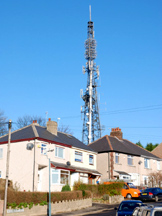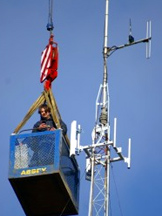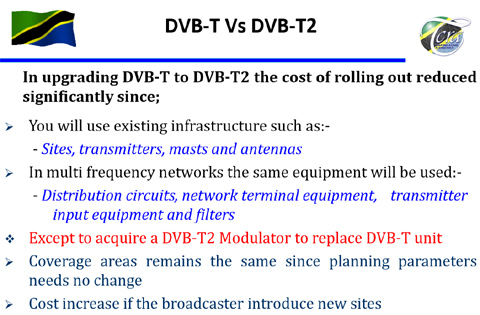Some time ago, Wireless Waffle discussed the various bidders to provide the television transmitter network for the UK's fledgling local TV stations. As part of this, the company responsible for providing the transmitters and masts for all of the other UK digital terrestrial television stations, tax evading transmitter supremos Arqiva, provided indicative figures for the costs of building the local TV transmitters. Their 'Reference Offer' details, on a site-by-site basis, the costs, as Arqiva saw them, of providing the requisite service together with the cost of providing 'network access' only (e.g. the rental of space on their masts). The figures vary by a factor of about 8 to 1 between different sites. But to what extent are Arqiva beefing up the actual costs to make a profit on their largely monopolistic position?
 Maybe an example would be useful, so let's consider their proposals for the Sheffield transmitter, one of the cheapest in their offer. Their prices are as follows:
Maybe an example would be useful, so let's consider their proposals for the Sheffield transmitter, one of the cheapest in their offer. Their prices are as follows:
According to Ofcom's local TV feasibility study, the technical details for the Sheffield site are:
 As for the annual costs, let's say it requires a visit every month to check on how it's working and this is one person dedicated for the day (though no doubt they would be checking on all the other transmitters on the site too), at a reasonable estimate of GBP 500 per day, to include the cost of petrol and transport, this equates to GBP 6000 per year. The power required for a 28 Watt transmitter assuming it is 20% efficient, is 140 Watts (equating to 1,227 kWh of electricity per year) which at today's prices would cost around GBP 122 per year. Allowing a further GBP 500 per month towards the maintenance of the buildings, air conditioning, mast and so forth (noting that these will have already been paid for by the existing tennants), the total annual fees would be around GBP 12,122. The annual fee proposed by Arqiva is therefore not as badly over-egged, no doubt the 'management fee' covers a lot of this difference.
As for the annual costs, let's say it requires a visit every month to check on how it's working and this is one person dedicated for the day (though no doubt they would be checking on all the other transmitters on the site too), at a reasonable estimate of GBP 500 per day, to include the cost of petrol and transport, this equates to GBP 6000 per year. The power required for a 28 Watt transmitter assuming it is 20% efficient, is 140 Watts (equating to 1,227 kWh of electricity per year) which at today's prices would cost around GBP 122 per year. Allowing a further GBP 500 per month towards the maintenance of the buildings, air conditioning, mast and so forth (noting that these will have already been paid for by the existing tennants), the total annual fees would be around GBP 12,122. The annual fee proposed by Arqiva is therefore not as badly over-egged, no doubt the 'management fee' covers a lot of this difference.
So, in conclusion:
The study makes the assumptions that:

Source: Assessing the technical requirements and implications of DVB-T transitions
The 'cost per transmitter' given in the report ranges from EUR 20,000 to around EUR 50,000, which seems reasonable given the assumptions made. Arqiva's estimate for re-tuning the UK's transmitter network to clear the 700 MHz band provides values ranging from GBP 310 to GBP 470 million (approximately EUR 400 to EUR 600 million) putting the price for re-farming the 700 MHz band in the UK at approximately the same level as the Commission report identifies for the whole of the EU!
There are approximately 1,200 transmitter sites in the UK, the smaller ones with three multiplexes on them and the larger 90 or so with six, seven or eight, making roughly 4,000 transmitters in the UK. Taking the consultants' report's 'per transmitter' value, the price for re-farming the spectrum in the UK ought to be nearer to EUR 80 to 200 million, a factor of 2 to 8 times removed from the prices quoted by Arqiva, depending on which end of the ranges quoted you take.
So who is right? It seems that the two reports are doing something slightly different: Perhaps Ofcom should take a leaf from the Commission's book, and instead of trying to re-engineer the UK's DTT network to be the same, should instead take the opportunity to convert the network to be DVB-T2 only and save a lot of money in the process. Given the timetable for the clearance of the 700 MHz band (e.g. around 2020), and that typical television replacement cycles are 7 years, the average British household would already have a T2 receiver by then... Then again, no doubt Arqiva could find some 'management costs' to soak up any savings!
Perhaps Ofcom should take a leaf from the Commission's book, and instead of trying to re-engineer the UK's DTT network to be the same, should instead take the opportunity to convert the network to be DVB-T2 only and save a lot of money in the process. Given the timetable for the clearance of the 700 MHz band (e.g. around 2020), and that typical television replacement cycles are 7 years, the average British household would already have a T2 receiver by then... Then again, no doubt Arqiva could find some 'management costs' to soak up any savings!
 Maybe an example would be useful, so let's consider their proposals for the Sheffield transmitter, one of the cheapest in their offer. Their prices are as follows:
Maybe an example would be useful, so let's consider their proposals for the Sheffield transmitter, one of the cheapest in their offer. Their prices are as follows:- GBP 147,397 one-off costs, and;
- an annual fee of GBP 17,783.
According to Ofcom's local TV feasibility study, the technical details for the Sheffield site are:
- Frequency: Television Channel 55, vertically polarised
- Transmitter power: 100 Watts e.r.p. requiring a transmitter output power of 28 Watts (taking into account antenna gain and cable loss)
- Antenna height: 43 metres
- Antenna type: 2 x log periodic on a bearing of 110 degrees
 As for the annual costs, let's say it requires a visit every month to check on how it's working and this is one person dedicated for the day (though no doubt they would be checking on all the other transmitters on the site too), at a reasonable estimate of GBP 500 per day, to include the cost of petrol and transport, this equates to GBP 6000 per year. The power required for a 28 Watt transmitter assuming it is 20% efficient, is 140 Watts (equating to 1,227 kWh of electricity per year) which at today's prices would cost around GBP 122 per year. Allowing a further GBP 500 per month towards the maintenance of the buildings, air conditioning, mast and so forth (noting that these will have already been paid for by the existing tennants), the total annual fees would be around GBP 12,122. The annual fee proposed by Arqiva is therefore not as badly over-egged, no doubt the 'management fee' covers a lot of this difference.
As for the annual costs, let's say it requires a visit every month to check on how it's working and this is one person dedicated for the day (though no doubt they would be checking on all the other transmitters on the site too), at a reasonable estimate of GBP 500 per day, to include the cost of petrol and transport, this equates to GBP 6000 per year. The power required for a 28 Watt transmitter assuming it is 20% efficient, is 140 Watts (equating to 1,227 kWh of electricity per year) which at today's prices would cost around GBP 122 per year. Allowing a further GBP 500 per month towards the maintenance of the buildings, air conditioning, mast and so forth (noting that these will have already been paid for by the existing tennants), the total annual fees would be around GBP 12,122. The annual fee proposed by Arqiva is therefore not as badly over-egged, no doubt the 'management fee' covers a lot of this difference.So, in conclusion:
- Arqiva seem to have extensively overpriced the capital work associated with providing and installing the local TV transmitter; but
- The proposed annual fee seems much more reasonable.
The study makes the assumptions that:
- Existing antennas are broadband and can be re-used;
- Existing transmitters will be upgraded rather than replaced.

Source: Assessing the technical requirements and implications of DVB-T transitions
The 'cost per transmitter' given in the report ranges from EUR 20,000 to around EUR 50,000, which seems reasonable given the assumptions made. Arqiva's estimate for re-tuning the UK's transmitter network to clear the 700 MHz band provides values ranging from GBP 310 to GBP 470 million (approximately EUR 400 to EUR 600 million) putting the price for re-farming the 700 MHz band in the UK at approximately the same level as the Commission report identifies for the whole of the EU!
There are approximately 1,200 transmitter sites in the UK, the smaller ones with three multiplexes on them and the larger 90 or so with six, seven or eight, making roughly 4,000 transmitters in the UK. Taking the consultants' report's 'per transmitter' value, the price for re-farming the spectrum in the UK ought to be nearer to EUR 80 to 200 million, a factor of 2 to 8 times removed from the prices quoted by Arqiva, depending on which end of the ranges quoted you take.
So who is right? It seems that the two reports are doing something slightly different:
- The Commission's report assumes that existing multiplexes and frequencies are converted to DVB-T2 and as such fewer are needed. In only very few cases would there therefore need to be a change in frequency, as the additional capacity of T2 (and MPEG-4) would mean existing frequencies could largely be re-used.
- The Arqiva report is trying to move all existing multiplexes (whether DVB-T or DVB-T2) to new frequencies, which is (clearly!) a much more expensive undertaking.
 Perhaps Ofcom should take a leaf from the Commission's book, and instead of trying to re-engineer the UK's DTT network to be the same, should instead take the opportunity to convert the network to be DVB-T2 only and save a lot of money in the process. Given the timetable for the clearance of the 700 MHz band (e.g. around 2020), and that typical television replacement cycles are 7 years, the average British household would already have a T2 receiver by then... Then again, no doubt Arqiva could find some 'management costs' to soak up any savings!
Perhaps Ofcom should take a leaf from the Commission's book, and instead of trying to re-engineer the UK's DTT network to be the same, should instead take the opportunity to convert the network to be DVB-T2 only and save a lot of money in the process. Given the timetable for the clearance of the 700 MHz band (e.g. around 2020), and that typical television replacement cycles are 7 years, the average British household would already have a T2 receiver by then... Then again, no doubt Arqiva could find some 'management costs' to soak up any savings!add comment
( 610 views )
| permalink
| 



 ( 2.8 / 87 )
( 2.8 / 87 )




 ( 2.8 / 87 )
( 2.8 / 87 )

